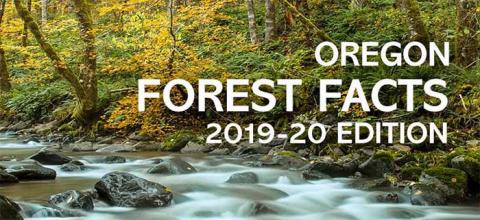The wait is over
January 29, 2019
The Oregon Forest Resources Institute (OFRI) has a very diverse set of stakeholders, including landowners, wood products manufacturers, foresters, educators, partner organizations, a variety of federal, state and local officials, architects, construction firms… and the list goes on. After meeting with all these stakeholders during my first few months as executive director, I can say with certainty that there is one OFRI publication that everyone requests: Oregon Forest Facts. In fact, many people I met pulled out a well-worn copy just to show how much it is used. By the time I started working for OFRI in July, we were down to our last stash of the 2017-2018 edition.
Oregon Forest Facts is published every two years with the latest facts on Oregon’s forests and their social, environmental and economic impact. Today, I am happy to say that the wait is over! We have released the Oregon Forest Facts 2019-2020 Edition. You can either order a free copy from our website, or if you need to get your hands on it right away, you can download a PDF version, as well as check out OregonForestFacts.org.
Here are some of the key takeaways from the 2019-2020 edition of Oregon Forest Facts:
- Nearly half of Oregon is forestland. Ownership of this land is split between government at 64 percent (federal, state and local), private landowners at 34 percent and Native American tribes at 2 percent.
- Oregon has done remarkably well in protecting forests, farms and rangeland from development. In fact, 97 percent of all non-federal land in Oregon that was in resource land uses in 1974 remained in those uses in 2014.
- More than 61,000 Oregonians are employed by the forest sector and depend on the state’s forests for their livelihood. The average annual wage of those jobs is $54,200, roughly 6 percent more than the average wage of $51,100 for all Oregon employment.
- Oregon leads the nation in production of softwood lumber. Oregon’s lumber output of 5.5 billion board feet in 2017 accounted for about 16.2 percent of total U.S. production.
- In 1971, Oregon became the first state in the nation to pass a comprehensive law regulating forest practices, the Oregon Forest Practices Act (OFPA), to ensure reforestation after timber harvest and to safeguard water, fish and wildlife habitat, soil and air. The OFPA has been updated 38 times since, to keep pace with scientific research.
Overall, the booklet highlights how our forests are one of Oregon’s greatest treasures. They provide a wonderful place to recreate with our friends and family, and offer the cleanest water in the state, abundant habitat for fish and wildlife, and family-wage jobs.
A great deal of time and effort goes into producing Oregon Forest Facts, and this latest version would not have been possible without the work of OFRI staff, especially Mike Cloughesy, Inka Bajandas and Jordan Benner. I hope you enjoy the Oregon Forest Facts 2019-2020 Edition; I know we already have another bestseller!
For the forest,
Erin Isselmann
Executive Director
